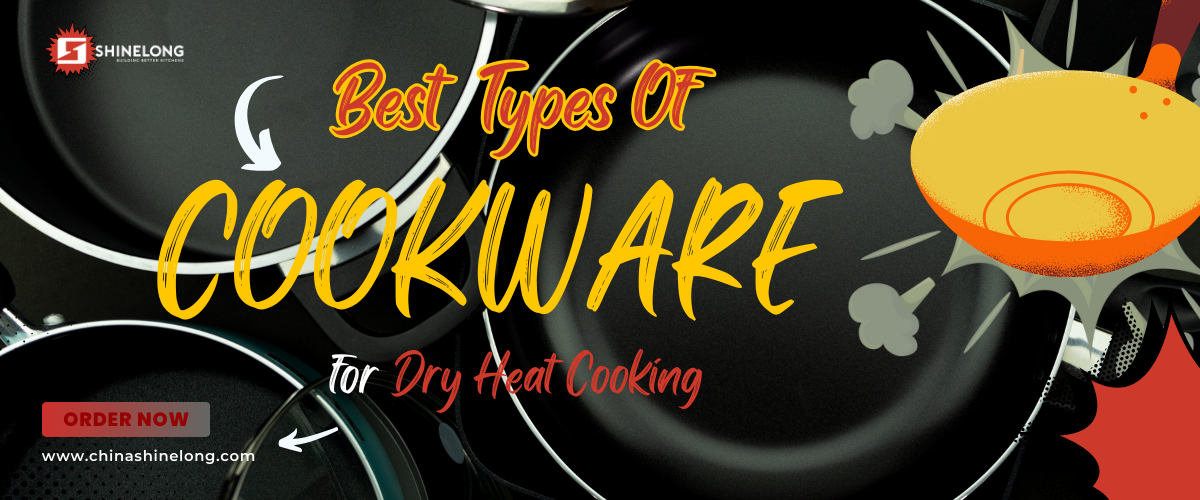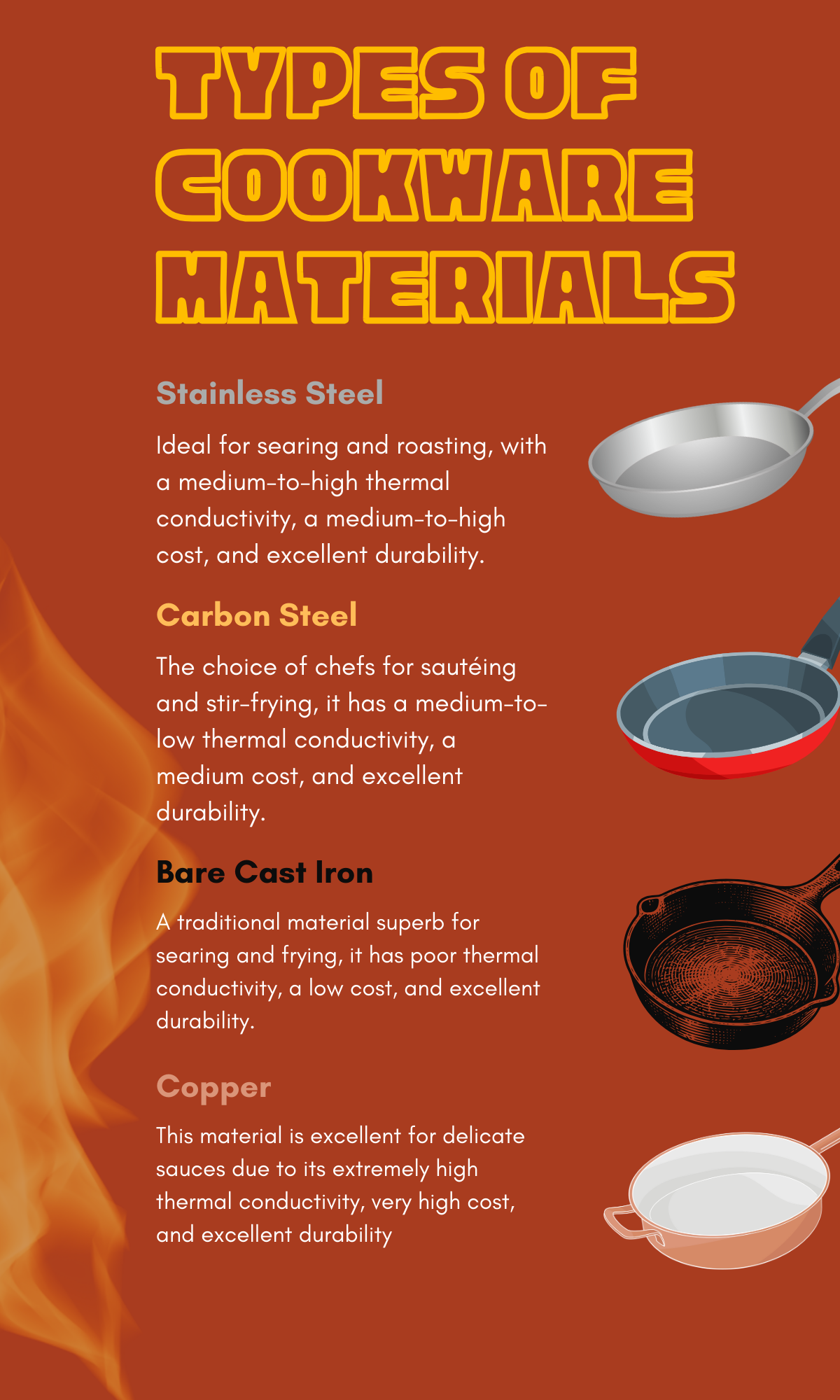News
Best Cookware Materials for Dry Heat Cooking

Choosing the right types of cookware materials for your restaurant is extremely important when cooking with dry heat. However, there is a wide range of cookware options, such as stainless steel, cast iron, or copper. Picking the wrong tool for the cooking method can definitely lead to risks like overcooking, which eventually affects your guests' dining experience. In this guide, we are going to walk you through four main types of cookware materials and help you make a wise decision.
What Does Dry Heat Mean in Cooking?
The core definition of the dry heat cooking method is cooking without moisture. It works by exposing ingredients to high temperatures, transferring heat directly throughout the entire cooking process, and allowing surface browning through Maillard reactions and caramelization. Common types of dry heat cooking include baking, frying, grilling, and more. This is why it is important to understand the key features of different cookware materials, which can help us select the best pans or pots to put above commercial stoves.
• Thermal Conductivity
This concept is very easy to understand, refers to how quickly heat moves through the material. For instance, pure metal materials like copper and aluminum are excellent conductors, way too fast for stainless steel or cast iron/carbon steel. High conductivity means the cookware heats up and cools down quickly, giving chefs precise, instant control over temperature.
• Heat Capacity
This is another point to estimate the better material when it comes to choosing the cookware, which means the ability of a material to store heat and maintain stable temperatures. In this area, cast iron is the top option. It is dense and heavy, so once heated, it retains its temperature for a long time. Even when cold ingredients are added, the pan stays hot without sudden drops.
• Reactivity
If you are looking for the secret to mastering dry heat cooking, the connection between cookware materials and food is something you can’t ignore. Reactivity is the key. Stainless steel is non-reactive, which means you can safely cook acidic or alkaline foods without changing their flavor. On the other hand, untreated cast iron, carbon steel, and pure aluminum are reactive. When they come into contact with acidic foods, they may break down or leave a metallic taste. This is why proper seasoning is essential to create a protective layer.
Types of Cookware Materials for Dry Heat Cooking
In this part, we will go over these four different types of cookware materials, ensuring you can grasp the correct kitchen tools for the menu.
Stainless Steel
Traditional stainless steel is a poor heat conductor, which often creates hot spots and uneven cooking. To solve this issue, the innovative “clad” construction has become a modern solution in commercial kitchens.
By bonding layers of conductive metals, such as aluminum or copper, to stainless steel, a multi-layer design like tri-ply or five-ply is formed. This combines stainless steel’s durability and non-reactivity with aluminum or copper’s fast, even heat transfer.
Ideal for: Clad stainless steel cookware provides even heating, good heat retention, and versatile performance. It is great for dry heat methods like searing, roasting, and stir-frying. Its non-reactive surface also makes it great for sauces and easy to scale to capture rich flavors.
Cast Iron
Cast iron is known for its incredible heat retention. Although it heats up slowly due to its poor thermal conductivity, its heavy mass allows it to store and maintain heat for a long time, making it an ideal choice for frying and searing. However, cast iron can develop hot spots directly above the heat source, like an open flame or an induction cooker, so it requires gradual preheating for even cooking.
Best uses: Cast iron is an ideal cookware material for dry heat cooking methods such as pan-frying, searing steaks, roasting meats, baking cornbread, and even shallow frying. Its ability to withstand extreme heat without damage makes it an essential option for both home cooks and professional kitchens.
Carbon Steel
As one of the most popular cookware materials in commercial kitchens, carbon steel is often seen as a lighter, more responsive alternative to cast iron. Made from about 99% iron and 1% carbon, it heats up and cools down quickly, allowing chefs to have excellent control over cooking temperatures. Its smoother stamped surface also makes it easier to help nourish a natural non-stick layer with regular seasoning.
Ideal for: Carbon steel is highly valued for cooking with dry heat tasks that require high temperature and quick movement, such as stir-frying. The heat retention and lightweight also make it a fantastic solution for searing beef and roasting vegetables, offering practicality without the heaviness of cast iron.
Pure Metals: Copper\Aluminum
Among the four major cookware materials, copper is the best in thermal conductivity and responsiveness. As a visually appealing material, it is popular in fine dining open kitchens or luxury catering events. However, copper is heavy, expensive, and highly reactive with food, which is why it usually requires a stainless steel or tin lining.
Aluminum ranks just below copper in heat conductivity, but is much lighter and more affordable. For this reason, it is widely used as the heat-conducting core in many multi-layered or clad cookware. Pure aluminum, however, is reactive with acidic foods and tends to warp under high heat, which is why it is rarely used on its own in professional kitchens.

What Do You Need to Know Before Buying the Cookware
As a crucial part of any commercial kitchen, cookware deserves just as much attention as appliances. Picking the right pots and pans isn’t only force on shape or size; selecting materials that align with your menu and cooking equipment is a priority. For instance, a steakhouse might favor cast iron for its excellent heat retention, while a busy bistro could benefit from lightweight aluminum-core pans that handle high turnover with ease. Safety should also remain a priority: opting for cookware materials that resist warping, overheating, and chemical reactions not only guarantees consistent cooking results but also provides long-term reliability and peace of mind in a demanding kitchen.
Check the best cookware sets in Shinelong
 After-Sales:
After-Sales:
 EN
EN
 AR
AR
 HR
HR
 NL
NL
 FI
FI
 FR
FR
 DE
DE
 EL
EL
 HI
HI
 IT
IT
 PT
PT
 RO
RO
 RU
RU
 ES
ES
 TL
TL
 ID
ID
 SL
SL
 VI
VI
 ET
ET
 MT
MT
 TH
TH
 FA
FA
 AF
AF
 MS
MS
 IS
IS
 MK
MK
 HY
HY
 AZ
AZ
 KA
KA
 UR
UR
 BN
BN
 BS
BS
 KM
KM
 LO
LO
 LA
LA
 MN
MN
 NE
NE
 MY
MY
 UZ
UZ
 KU
KU









